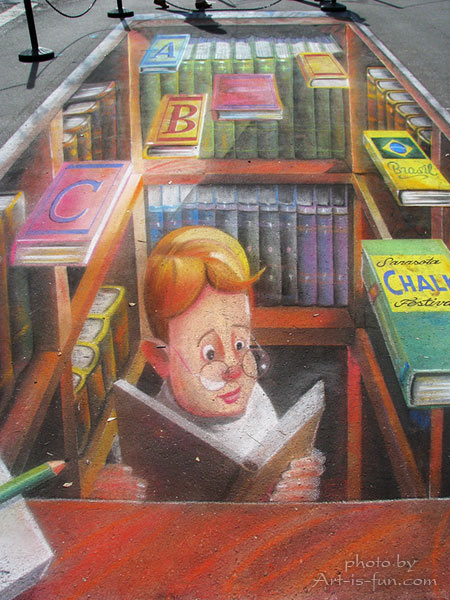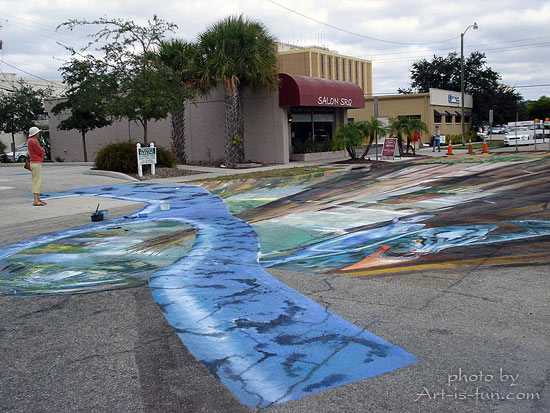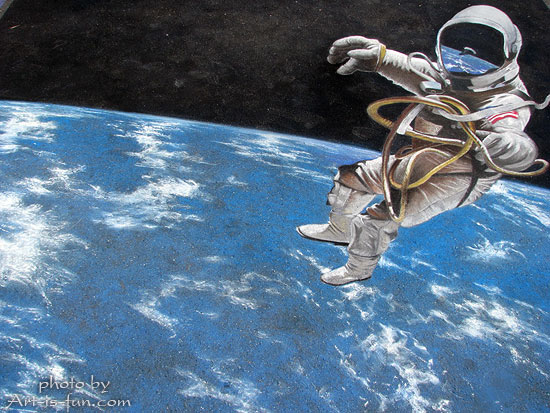Sidewalk Chalk Drawings
3D sidewalk chalk drawings are fun, interactive, ephemeral works of art that dazzle, inspire and amaze. With the right skills and tools, pavement artists can transform ordinary sidewalks into breathtaking portals to another dimension, defying the laws of space and time as people and creatures appear to emerge from the concrete and step into our world.
The Four Continents by Julie Kirk-Purcell at the Sarasota Chalk Festival in Florida
Even if you've never seen pavement chalk art in real life, chances are you've seen some of the stunning photos circulating the Internet by renowned pavement artists such as Kurt Wenner or Julian Beever. Since sidewalk chalk drawings get washed away in the rain or worn away by time, photographs provide an excellent way of preserving the art for all to enjoy.
3D pavement chalk drawing by Eduardo Kobra of Brazil at the Sarasota Chalk Festival
Sidewalk chalk drawing is also commonly referred to as: pavement art, sidewalk art, street painting, 3-D chalk art, 3-D pavement art, or anamorphic street painting, among other terms.
Although some artists might use chalk or paint to create these drawings, most "chalk artists" use professional-quality pastels that allow for bright colors in a range of hues.
Optical Illusions in 3D Sidewalk Art
The wonder of 3-D sidewalk chalk drawings is that they can transform a familiar, ordinary setting into something fantastical and out of this world. A portal is opened and the imagination is unfurled. Possibilities abound... but the artwork only looks "correct" when seen from a certain angle.
Here's an example. Can you tell what's being depicted in the painting below?
From this angle, the artwork looks strangely distorted, and it's hard to tell what it's supposed to look like.
Here's the same image from another view. Can you make out the image that all those people are crowding around to see?
Lego Army by Leon Keer at the Sarasota Chalk Festival 2011
What a remarkable difference it makes when you view the art from the correct angle! It actually looks like there is a giant hole in the pavement filled with terracotta Lego figures.
This phenomenon is known as "perspectival anamorphosis", which means that the artwork will look 3-dimensional when viewed from a specific angle, but will appear totally skewed from other angles. "Anamorphic drawing" is another way of describing these types of 3-D pavement drawings.
Anamorphosis was a technique discovered in the early Renaissance, when artists painted ceilings to depict towering architecture and a floating menagerie of figures, some appearing closer and others appearing to be higher up, as if they were inhabiting an actual 3-D space. Anamorphic perspective flourished well into the Baroque and Rococo eras.
A classic example is the ceiling of this Jesuit Church in Vienna, painted by Andrea Pozzo in 1703:
Anamorphic perspective painting on a church ceiling, by Andrea Pozzo.
(photo courtesy Alberto Fernandez via Wikimedia Commons)
When you look at the photo above, it looks like there is a dome in the ceiling of this church, right? You might be surprised to learn that this church does not have a dome, and what you see is a painting on a flat part of the ceiling!
This same concept of anamorphic perspective inspires today's most ambitious chalk artists.
In the 1980s, American artist Kurt Wenner adapted the Renaissance techniques of perspectival anamorphosis, transferring it from the soaring cathedral ceilings to the ground beneath our feet. This brought a whole new dimension to sidewalk chalk drawings. Today the most enchanting examples of pavement art involve some type of perspectival anamorphosis.
Here's another example. When you look at this large chalk drawing from the side, it looks like an elongated smear of colors:
When you look through a special glass, the image suddenly makes sense! You can recognize a scene from Jim Cameron's film Avatar:
Anamorphic sidewalk chalk drawing by Gregor Wosik
The most common illusions of pavement art involve people, objects and/or creatures emerging from (or falling into) what appears to be a deep space in the ground.
Some of the most striking 3D anamorphic illusions invite viewer interaction or "participation" to help make the scene look believable. For instance, check out Julian Beever's chalk drawing of a man about to jump into a waterfall or his drawing of a man falling off of a scaffolding. The presence of a real human in these images makes these sidewalk chalk drawings seem even more real!
2D Sidewalk Chalk Drawings
Chalk art doesn't need to be 3D to be impressive, though! 2D chalk drawings are just as fascinating to behold. It is especially admirable how these talented artists use their skills to turn pavement into temporary canvases, creating beautiful works of art that will inevitably disappear:
Chalk drawing by Michael Las Casas
Chalk drawing by Cuong Nguyen at Sarasota Chalk Festival
Chalk drawing by Julio Jimenez at the Sarasota Chalk Festival 2011
A Brief History of Sidewalk Chalk Drawings
Today's pavement art is a modern twist on a centuries-old tradition. In the 16th century, Italian artists known as "madonnari" created chalk drawings of the Madonna. They traveled from town to town, earning their living from the coins that people would toss to them as they drew on the ground.
By the mid-1900s, the street painting tradition was starting to fizzle away. To help revive this dying art form, a festival was launched in 1972 in a northern Italian town called Grazie di Curtatone. Held every year in August to coincide with the Feast of the Assumption, chalk artists are given 24 hours to create a finished work of pavement art based on religious or Renaissance themes, starting in the evening and working through the night - which is no easy feat!
The Grazie di Curtatone competition now attracts 200,000+ visitors each year and is credited with reviving public interest in pavement chalk drawing.
Madonnari competition in Grazie di Curtatone, Italy
(Photo by Luca Volpi via Wikimedia Commons)
The first sidewalk chalk drawing festival was held in the US in the late 1980s, thanks to American artist Kurt Wenner, a 3-time winner of the Grazie di Curtatone. The Santa Barbara I Madonnari Festival in California is the longest-running US chalk festival, with dozens of other chalk festivals now appearing annually in cities all over North America, such as the Sarasota Chalk Festival in Florida, where many of the photos on this page were taken.
Sidewalk chalk festivals bring together the artists and their audience, allowing spectators the chance to see art as it is being created. In some ways this helps demystify the artistic process for those who would otherwise have no contact with art or artists. Oftentimes viewers will speak to the artists as they are working, whether they are asking questions or showering the artists with praise.
Sarasota Chalk Festival 2011
Noteworthy 3-D Pavement Artists
Kurt Wenner
Kurt Wenner was one of the pioneers of modern sidewalk chalk drawing. In 1982 he quit his job at NASA as an advanced scientific space illustrator and moved to Italy where he immersed himself in the study of Renaissance Classicism. He participated several times in the Grazie di Curtatone competition and invented the concept of 3D (or "anamorphic") pavement art. In 1985 he was the subject of National Geographic's documentary "Masterpieces in Chalk".
In 1996, Wenner created "Absolut Wenner", the first street painting that was commissioned by a company for publicity purposes. (You can see the ad here.) In 2010, he created a 22 square meter 3D chalk art drawing for Greenpeace that called for a ban of GMOs.
In short, Wenner was instrumental in popularizing pavement art around the world. He has also dedicated much of his time to teaching students (from youngsters to college-age) how to use chalk and pastels.
Julian Beever
Julian Beever has recreated Classical paintings as pavement drawings, but is perhaps more popularly known for his modern, whimsical imagery involving comic book heroes, giant frogs and snails, and scenes that create a sense of action and movement, such as this sidewalk drawing of white water rafting. Julian's anamorphic artwork is meant to be interacted with to have the highest impact. By placing a real person into the art, the illusion is complete.
Other noteworthy sidewalk chalk artists include:
Edgar Mueller - well-known for his large chalk drawings that appear to involve steep, dramatic drops. (You can also read an article about Edgar and his work here.)
Tracy Lee Stum - famous for her 3-D interactive street drawings
Melanie Stimmell - creates Renaissance-inspired pavement drawings and also runs the We Talk Chalk Academy.
Julie Kirk-Purcell - creates illusionistic 3-D chalk pavement drawings


















